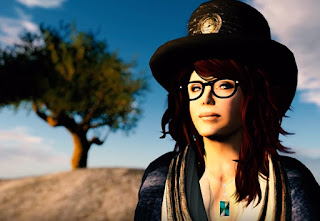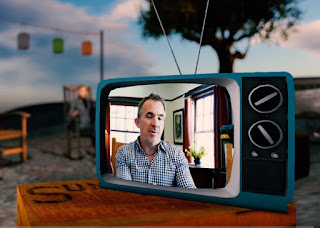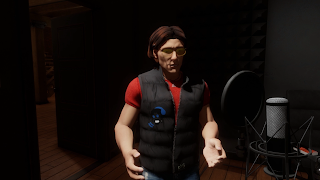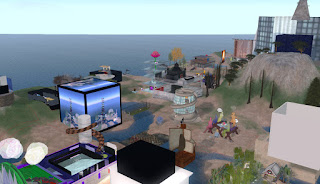By Gentle Heron
 |
| Slatan & iSkye in Second Life. Click to watch the film Our Digital Selves |
I interviewed them together as avatars in a virtual world, which is how I know them. The interview was conducted in text chat, and edited for continuity.
Q- In your opinion, what was the value of this research?
SD- It’s been a challenge for everyone who was involved, but so therapeutic for many of us.
iS- Some of us never met before and formed new friendships.
Q- In addition to the research project, the documentary was another way to be “heard.” How did you feel about participating in the documentary? Was it difficult to do?
SD- I was terrified in the beginning during the interview. It’s not easy to explain my feelings in a foreign language, and properly.
iS- You did very well. I was nervous about using voice.
SD- Now everyone loves her voice.
iS- It’s not my first time using voice in Second Life, but this went on film and is being heard literally worldwide. That was what scared me.
Q- So you helped each other be brave?
iS- We did!
SD- Yes.
iS- Though Drax interviewed each of us separately, it made me smile how our comments dovetailed so well. Slatan and I were saying complementary things without even knowing it.
SD- Everyone was so brave to come out in RL too.
iS- They put into words things that a lot of us think and feel.
Q- Yes, I was glad to meet the "RL selves" behind some of my VAI friends’ avatars. Did you learn anything about your fellow Ethnographians from the film that you did not already know? Did they learn more about you?
SD- I would say we have learned much, not knowing their other side of the mirror, so private in same cases. During the meetings everyone was telling in general some aspects of their life, but never so deeply, and everyone has a different view about what their own avatar is and represents.
iS- A lot of it went to trust. How much could we trust Drax with what we were telling him? "What does my avatar mean to me?" The questions he asked were kind of open-ended so we could tell however much or little we were comfortable sharing, but it still went to trusting Drax with the information we did give him.
SD- Yes, and nothing being prepared in advance, it was a free talk. We were free to express ourselves.
iS- I told Drax a lot about my childhood, growing up, my experience with my family, work experiences, etc., and I know he spent hours with each of us. The way he put the film together, edited it, he kept the most significant things we said. He had hours and hours of footage and recordings, and he had to edit that down to an hour and a quarter. He told us there were things he wished he could keep in, but perhaps another time, who knows.
SD- Yes, he cut part of my interview.
Q- But you knew ahead of time that he would. That’s how film making is.
iS- Yes, we did. We’re not complaining about it, just saying we knew that would be necessary. Originally the film was supposed to be much, much shorter. I think it would not have the same impact as it does in its current form.
 |
| iSkye Silverweb |
iS- I've been active in my local area as a Deaf activist. Here my focus is broader, because there is strength in numbers.
SD- Honestly I don’t feel like an activist, but more than Ethnographia, being part of Virtual Ability [often abbreviated VAI] opened my view on people with disabilities.
Q- Did you learn about other types of disabilities, and did other people learn more about your disability, from the Ethnographia project and the filming?
SD- I did yes, knowing different disabilities and or form of them.
iS- I learned a great deal about each person's experience with their disability through the film, and at times some of us shared that in our meetups. I think when Drax released the teaser with me in it, the Ethnographians became a bit more aware of what things are like for me. They became a lot more sensitive to the need for text in the meetups. In Sansar, they try to remember to include me in text. That all came about because of the film. It helped them to understand what it's like.
SD- But again, being in contact with people from VAI opened my mind.
iS- Yes! For me too, because I came to understand the benefits of virtual worlds for VAIers with different disabilities.
Q- People talk about "the" community of persons with disabilities. Is there one?
iS- If you mean just one community, it's a loosely connected one. There are so many levels of community: global, local, state, national, and different groups online and inworlds. Virtual Ability is one, Ethnographia is another, Dreams is another. And we call them communities, too, not just groups.
Q- Why is that?
iS- The mutual support aspect.
SD- Affinity.
iS- Coming together for a common purpose and with us it would be mutual support and the ability to be around other people who 'get' disability. Shyla made a comment about the 'screen generation,' the attitude that being in virtual worlds is 'addictive.' 'You need to be part of the world, not shut off from it.' Yeah, well...when I am in a room full of people I am still isolated, in the physical world. I can't communicate easily with other people, especially in group settings. Inworld, it is so much easier for me to understand everybody and to do things, to be empowered to do things. Text-enabled is me :)
SD- Because for some, that is the world outside.
iS- What Slatan said, the virtual world IS the outside world for some of us.
Q- You participated in a research project as a participant, even though in the video you are only shown as avatars. Would you feel comfortable being part of additional research studies conducted in a virtual world?
iS- Depends who is conducting the study and why.
I think what really helped us was that all along the process of the work on the film, Drax, Tom and Tredi shared with us what they were doing, and why. Tom was spot-on in explaining the “shift” I was describing with my experience. This is because of frequent meetups over the course of three years, with the film work during the last year. The researchers took time to get to know and understand us, and to let us come to trust them. I think this is important to any research study; you won’t understand the messages of the individuals without really spending time with them.
I don’t expect other studies to go that long, but I appreciate when researchers take time to get to know and understand the individuals who are participating in the study. I especially love it when they may start out “embedding” in the community, but then become members and friends IN the community after their research projects wrap up. I don’t know if researchers are prevented from doing that after their work is done, but I can tell you, I miss some of the people who came to SL to conduct studies – as graduate students, research professionals, medical researchers – and then left SL, and we don’t have an ongoing connection with them.
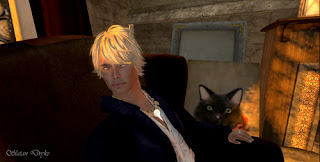 |
| Slatan Dryke |
Q- Do you feel this type of research yields valid results?
iS- The research that was done in connection with the “Our Digital Selves” project gave some very compelling results. Tom and Tredi put into words in a very clear way the things that we had been trying to say to people for years.
SL and virtual worlds are not “addictive,” “games,” or “time wasters.” For so many of us, they provide a way for us to connect to other people, to overcome the various forms of isolation that we experience, to be able to do meaningful things, and to be able to define US, ourselves, instead of having labels put onto us. I think the film brought that out very well.
If more studies are needed to add to the research and other findings, and to make it more possible and easier for other people with disabilities to enter virtual worlds and connect with others, I think it is a good thing.

